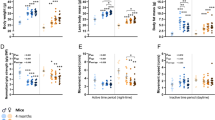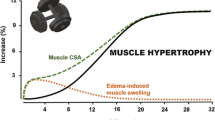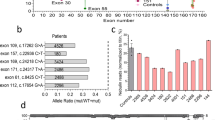Abstract
Skeletal muscle (SkM) comprises slow and fast-twitch fibers, which differ in molecular composition, function, and systemic energy consumption. In addition, muscular dystrophies (DM), a group of diverse hereditary diseases, present different patterns of muscle involvement, progression, and severity, suggesting that the regeneration-degeneration process may differ depending on the muscle type. Therefore, the study aimed to explore the expression of proteins involved in the repair process in different muscles at an early stage of muscular dystrophy in the δ-sarcoglycan null mice (Sgcd-null), a limb-girdle muscular dystrophy 2 F model. Hematoxylin & Eosin (H&E) Staining showed a high number of central nuclei in soleus (Sol), tibialis (Ta), gastrocnemius (Gas), and extensor digitorum longus (Edl) from four months Sgcd-null mice. However, fibrosis, determined by trichrome of Gomori modified staining, was only observed in Sgcd-null Sol. In addition, the number of Type I and II fibers variated differentially in the Sgcd-null muscles vs. wild-type muscles. Besides, the protein expression level of β-catenin, myomaker, MyoD, and myogenin also presented different expression levels in all the Sgcd-null muscles studied. In summary, our study reveals that muscles with different metabolic characteristics showed distinct expression patterns of proteins involved in the muscle regeneration process. These results could be relevant in designing therapies for genetic and acquired myopathy.




Similar content being viewed by others
References
Alexander MS, Kawahara G, Motohashi N et al (2013) MicroRNA-199a is induced in dystrophic muscle and affects WNT signaling, cell proliferation, and myogenic differentiation. Cell Death Differ 20:1194–208. https://doi.org/10.1038/cdd.2013.62
Alonso-Perez J, Gonzalez-Quereda L, Bello L et al (2020) New genotype-phenotype correlations in a large european cohort of patients with sarcoglycanopathy. Brain 143:2696–2708. https://doi.org/10.1093/brain/awaa228
Barateau A, Vadrot N, Agbulut O, Vicart P, Batonnet-Pichon S, Buendia B (2017) Distinct fiber type signature in mouse muscles expressing a mutant lamin a responsible for congenital muscular dystrophy in a patient. Cells. https://doi.org/10.3390/cells6020010
Bassel-Duby R, Olson EN (2006) Signaling pathways in skeletal muscle remodeling. Annu Rev Biochem 75:19–37. https://doi.org/10.1146/annurev.biochem.75.103004.142622
Bloemberg D, Quadrilatero J (2012) Rapid determination of myosin heavy chain expression in rat, mouse, and human skeletal muscle using multicolor immunofluorescence analysis. PLoS ONE 7:e35273. https://doi.org/10.1371/journal.pone.0035273
Brand-Saberi B, Christ B (1999) Genetic and epigenetic control of muscle development in vertebrates. Cell Tissue Res 296:199–212. https://doi.org/10.1007/s004410051281
Brunelli S, Relaix F, Baesso S et al (2007) Beta catenin-independent activation of MyoD in presomitic mesoderm requires PKC and depends on Pax3 transcriptional activity. Dev Biol 304:604–614. https://doi.org/10.1016/j.ydbio.2007.01.006
Chen B, You W, Shan T (2019) Myomaker, and myomixer-myomerger-minion modulate the efficiency of skeletal muscle development with melatonin supplementation through Wnt/beta-catenin pathway. Exp Cell Res 385:111705. https://doi.org/10.1016/j.yexcr.2019.111705
Ciena AP, de Almeida SR, Alves PH, Bolina-Matos Rde S, Dias FJ, Issa JP, Iyomasa MM, Watanabe IS (2011) Histochemical and ultrastructural changes of sternomastoid muscle in aged Wistar rats. Micron 42:871–876. https://doi.org/10.1016/j.micron.2011.06.003
Coral-Vazquez R, Cohn RD, Moore SA, Hill JA, Weiss RM, Davisson RL, Straub V, Barresi R, Bansal D, Hrstka RF, Williamson R, Campbell KP (1999) Disruption of the sarcoglycan-sarcospan complex in vascular smooth muscle: a novel mechanism for cardiomyopathy and muscular dystrophy. Cell 98:465–474. https://doi.org/10.1016/s0092-8674(00)81975-3
Cui S, Li L, Yu RT, Downes M, Evans RM, Hulin JA, Makarenkova HP, Meech R (2019) beta-catenin is essential for differentiation of primary myoblasts via cooperation with MyoD and alpha-catenin. Development 146:dev167080. https://doi.org/10.1242/dev.167080
D’Antona G, Brocca L, Pansarasa O et al (2007) Structural and functional alterations of muscle fibres in the novel mouse model of facioscapulohumeral muscular dystrophy. J Physiol 584:997–1009. https://doi.org/10.1113/jphysiol.2007.141481
Davies KE, Nowak KJ (2006) Molecular mechanisms of muscular dystrophies: old and new players. Nat Rev Mol Cell Biol 7:762–773. https://doi.org/10.1038/nrm2024
Davis RL, Cheng PF, Lassar AB, Weintraub H (1990) The MyoD DNA binding domain contains a recognition code for muscle-specific gene activation. Cell 60:733–746. https://doi.org/10.1016/0092-8674(90)90088-v
Dowling JJ, Weihl CC, Spencer MJ (2021) Molecular and cellular basis of genetically inherited skeletal muscle disorders. Nat Rev Mol Cell Biol 22:713–732. https://doi.org/10.1038/s41580-021-00389-z
Evano B, Gill D, Hernando-Herraez I, Comai G, Stubbs TM, Commere PH, Reik W, Tajbakhsh S (2020) Transcriptome and epigenome diversity and plasticity of muscle stem cells following transplantation. PLoS Genet. https://doi.org/10.1371/journal.pgen.1009022. 16;e1009022
Jones AE, Price FD, Le Grand F, Soleimani VD, Dick SA, Megeney LA, Rudnicki MA (2015) Wnt/beta-catenin controls follistatin signalling to regulate satellite cell myogenic potential. Skelet Muscle 5:14. https://doi.org/10.1186/s13395-015-0038-6
Kallabis S, Abraham L, Muller S, Dzialas V, Turk C, Wiederstein JL, Bock T, Nolte H, Nogara L, Blaauw B, Braun T, Kruger M (2020) High-throughput proteomics fiber typing (ProFiT) for comprehensive characterization of single skeletal muscle fibers. Skelet Muscle 10:7. https://doi.org/10.1186/s13395-020-00226-5
Kornegay JN, Childers MK, Bogan DJ et al (2012) The paradox of muscle hypertrophy in muscular dystrophy. Phys Med Rehabil Clin N Am 23:149–172. https://doi.org/10.1016/j.pmr.2011.11.014
Liewluck T, Milone M (2018) Untangling the complexity of limb-girdle muscular dystrophies. Muscle Nerve 58:167–177. https://doi.org/10.1002/mus.26077
Marini JF, Pons F, Leger J, Loffreda N, Anoal M, Chevallay M, Fardeau M, Leger JJ (1991) Expression of myosin heavy chain isoforms in Duchenne muscular dystrophy patients and carriers. Neuromuscul Disord 1:397–409. https://doi.org/10.1016/0960-8966(91)90003-b
Millay DP, O’Rourke JR, Sutherland LB, Bezprozvannaya S, Shelton JM, Bassel-Duby R, Olson EN (2013) Myomaker is a membrane activator of myoblast fusion and muscle formation. Nature 499:301–305. https://doi.org/10.1038/nature12343
Ozkok E, Yorulmaz H, Ates G, Serdaroglu-Oflazer P, Tamer AS (2014) Effects of prior treatment with simvastatin on skeletal muscle structure and mitochondrial enzyme activities during early phases of sepsis. Int J Clin Exp Pathol 7:8356–8365. https://www.ncbi.nlm.nih.gov/pubmed/25674200
Pedemonte M, Sandri C, Schiaffino S, Minetti C (1999) Early decrease of IIx myosin heavy chain transcripts in Duchenne muscular dystrophy. Biochem Biophys Res Commun 255:466–469. https://doi.org/10.1006/bbrc.1999.0213
Rubenstein AB, Smith GR, Raue U, Begue G, Minchev K, Ruf-Zamojski F, Nair VD, Wang X, Zhou L, Zaslavsky E, Trappe TA, Trappe S, Sealfon SC (2020) Single-cell transcriptional profiles in human skeletal muscle. Sci Rep 10:229. https://doi.org/10.1038/s41598-019-57110-6
Sanchez Riera C, Lozanoska-Ochser B, Testa S, Fornetti E, Bouche M, Madaro L (2021) Muscle diversity, heterogeneity, and gradients: learning from sarcoglycanopathies. Int J Mol Sci 22:2502. https://doi.org/10.3390/ijms22052502
Schiaffino S, Reggiani C (2011) Fiber types in mammalian skeletal muscles. Physiol Rev 91:1447–1531. https://doi.org/10.1152/physrev.00031.2010
Schmidt M, Schuler SC, Huttner SS, von Eyss B, von Maltzahn J (2019) Adult stem cells at work: regenerating skeletal muscle. Cell Mol Life Sci 76:2559–2570. https://doi.org/10.1007/s00018-019-03093-6
Shavlakadze T, Chai J, Maley K et al (2010) A growth stimulus is needed for IGF-1 to induce skeletal muscle hypertrophy in vivo. J Cell Sci 123(Pt 6):960–971. https://doi.org/10.1242/jcs.061119
Tasca G, Monforte M, Diaz-Manera J et al (2018) MRI in sarcoglycanopathies: a large international cohort study. J Neurol Neurosurg Psychiatry 89:72–77. https://doi.org/10.1136/jnnp-2017-316736
Vainzof M, Souza LS, Gurgel-Giannetti J, Zatz M (2021) Sarcoglycanopathies: an update. Neuromuscul Disord 31:1021–1027. https://doi.org/10.1016/j.nmd.2021.07.014
Wang YX, Rudnicki MA (2011) Satellite cells, the engines of muscle repair. Nat Rev Mol Cell Biol 13:127–133. https://doi.org/10.1038/nrm3265
Webster C, Silberstein L, Hays AP, Blau HM (1988) Fast muscle fibers are preferentially affected in Duchenne muscular dystrophy. Cell 52:503–513. https://doi.org/10.1016/0092-8674(88)90463-1
Westerblad H, Bruton JD, Katz A (2010) Skeletal muscle: energy metabolism, fiber types, fatigue and adaptability. Exp Cell Res 316:3093–3099. https://doi.org/10.1016/j.yexcr.2010.05.019
Williams K, Yokomori K, Mortazavi A (2022) Heterogeneous skeletal muscle cell and nucleus populations identified by single-cell and single-nucleus resolution transcriptome assays. Front Genet 13:835099. https://doi.org/10.3389/fgene.2022.835099
Wright WE, Sassoon DA, Lin VK (1989) Myogenin, a factor regulating myogenesis, has a domain homologous to MyoD. Cell 56:607–617. https://doi.org/10.1016/0092-8674(89)90583-7
Yablonka-Reuveni Z, Rivera AJ (1994) Temporal expression of regulatory and structural muscle proteins during myogenesis of satellite cells on isolated adult rat fibers. Dev Biol 164:588–603. https://doi.org/10.1006/dbio.1994.1226
Yeung EW, Head SI, Allen DG (2003) Gadolinium reduces short-term stretch-induced muscle damage in isolated mdx mouse muscle fibers. J Physiol 552:449–458. https://doi.org/10.1113/jphysiol.2003.047373
Acknowledgements
This publication was made possible by grants from CONACyT (140637) RMCV, JMHH, and SIP-IPN (2085) to RMCV. We want to thank Jorge Omar Garcia-Rebollar and Mónica Martínez Marcial for their support in the maintenance of the mouse colony and María Guadalupe Pérez Flores and Mirna Martínez Damas for technical assistance.
Author information
Authors and Affiliations
Corresponding author
Ethics declarations
Competing interests
The authors declare that they have no competing interests.
Additional information
Publisher’s Note
Springer Nature remains neutral with regard to jurisdictional claims in published maps and institutional affiliations.
Supplementary Information
Below is the link to the electronic supplementary material.
Rights and permissions
Springer Nature or its licensor (e.g. a society or other partner) holds exclusive rights to this article under a publishing agreement with the author(s) or other rightsholder(s); author self-archiving of the accepted manuscript version of this article is solely governed by the terms of such publishing agreement and applicable law.
About this article
Cite this article
Palma-Flores, C., Cano-Martínez, L.J., Fernández-Valverde, F. et al. Differential histological features and myogenic protein levels in distinct muscles of d-sarcoglycan null muscular dystrophy mouse model. J Mol Histol 54, 405–413 (2023). https://doi.org/10.1007/s10735-023-10136-7
Received:
Accepted:
Published:
Issue Date:
DOI: https://doi.org/10.1007/s10735-023-10136-7




